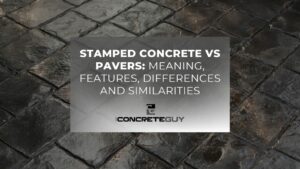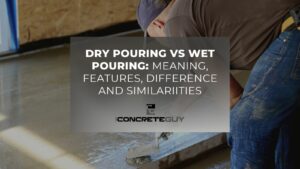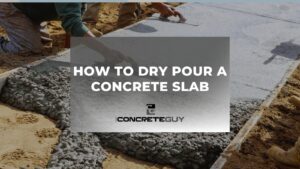Are you considering a concrete floor for your space but unsure whether to go for a sealed or polished finish? You might be intrigued by the durability, low maintenance, and distinctive rustic charm that comes after installing sealed concrete and polished floors.
However, before making a decision, it’s crucial to understand the differences between these two awesome concrete floors to choose the option that best suits your needs.
What are Sealed Concrete Floors?
Sealed concrete floors are concrete surfaces that have been treated with a protective sealant to enhance their performance and appearance. The sealing process involves applying a specialized sealant or coating onto the concrete surface to create a protective layer.
The sealing process typically consists of the following steps:
1. Surface preparation
The concrete surface is thoroughly cleaned and prepared to ensure proper adhesion of the sealant. This involves removing any dirt, stains, or contaminants that may hinder the sealing process. Cleaning methods may include pressure washing, chemical cleaning, or mechanical abrasion.
2. Application of sealant
Once the surface is clean and dry, the sealant is applied to the concrete. Sealants can be either topical or penetrating. Topical sealants create a protective film on the surface of the concrete, while penetrating sealants penetrate the concrete, forming a protective barrier from within.
3. Even coverage
The sealant is applied evenly across the entire concrete surface using brushes, rollers, or sprayers. This ensures that the sealant adheres properly and provides consistent protection.
4. Curing and drying
After the sealant is applied, it needs time to cure and dry. This allows it to form a strong and durable protective layer on the concrete surface. The curing time can vary depending on the type of sealant used and environmental conditions.
Pros of Sealed Concrete
- Ease of maintenance
- Increased durability
- Moisture protection
- Dust reduction
- Stain resistance
Cons of Sealed Concrete
- Periodic resealing
- Limited design options
- Slipperiness
What are Polished Concrete Floors?
Polished concrete floors are a type of flooring that involves mechanically grinding, honing, and polishing a concrete surface to achieve a smooth, glossy, and visually appealing finish. The polishing process transforms ordinary concrete into a refined and polished floor that showcases the natural beauty of the material.
The process of polishing concrete typically involves several steps. Here is a general overview of the process:
1. Surface preparation
Before polishing, the concrete surface must be thoroughly cleaned and prepared. This includes removing any existing coatings, adhesives, or contaminants that may hinder the polishing process. Grinding or shot blasting may be used to achieve a clean and uniform surface.
2. Grinding
Coarse diamond abrasives are used to grind down the surface of the concrete. This step removes any imperfections, such as minor cracks, stains, or unevenness. The grinding process is typically done in multiple passes, gradually refining the surface and achieving the desired level of smoothness.
3. Honing
After grinding, finer diamond abrasives are used to further smooth and refine the surface. This step helps to remove any marks or scratches left by the coarse grinding process. Honing can be performed with progressively finer grits of diamond abrasives until the desired level of smoothness and clarity is achieved.
4. Polishing
Once the surface has been honed, the polishing process begins. Polishing pads with increasingly fine grits are used to create a high-gloss finish. This step brings out the natural luster of the concrete, resulting in a reflective and visually appealing surface. Depending on the desired level of shine, the polishing process may involve several passes with different polishing pads.
5. Densifying and sealing (optional)
To enhance the durability and stain resistance of the polished concrete floor, a densifier may be applied. The densifier penetrates the concrete, filling in pores and increasing its hardness. Additionally, a sealer may be applied to further protect the polished surface and enhance its resistance to stains, chemicals, and wear.
Pros of Polished Concrete
- Enhanced light reflectivity
- Long lifespan
- Cost-effective
- Sleek and glossy appearance
- Environmental sustainability
Cons of Polished Concrete.
- Cold and hard surface
- Concrete limitations
Factors To Consider When Choosing Between Sealed And Polished Concrete
When deciding between sealed and polished concrete floors, several factors should be taken into consideration to ensure that the chosen option aligns with your specific needs and preferences. Here are some important ones to consider:
1. Budget
Determine your budget for the flooring project. Polished concrete floors generally require more extensive preparation and labor, which can result in higher upfront costs compared to sealed concrete floors. Consider the costs of materials, installation, and any necessary repairs or surface preparations when evaluating your budget.
2. Desired aesthetics
Think about the aesthetic appeal you want to achieve in your space. Polished concrete floors offer a sleek, glossy finish that can enhance the natural beauty of the concrete. Sealed concrete floors, on the other hand, can provide a range of finishes, including matte, semi-gloss, or high-gloss, depending on the type of sealant used. Factor in the overall look and feel you want to create in your space and choose the option that best aligns with your aesthetic goals.
3. Maintenance requirements
Assess the level of maintenance you are willing to undertake for the flooring. Polished concrete floors are generally easier to clean and maintain due to their smooth and sealed surface. They are resistant to stains and require regular sweeping and occasional damp mopping. Sealed concrete floors may require periodic resealing to maintain their protective properties and appearance. Also, your lifestyle, the level of foot traffic, and the time you can dedicate to maintenance when making your decision should be considered.
4. Intended use of the space
How do you want the space to be used? requirements it may have. Polished concrete floors are highly durable and well-suited for areas with heavy foot traffic, such as retail stores, offices, or public spaces. They are resistant to abrasion and can withstand wear and tear.
Sealed concrete floors can also be durable, but their specific performance will depend on the type of sealant used. Study the slip resistance, chemical resistance, and the potential need for additional coatings or treatments based on the intended use of the space.
5. Personal preferences
Your personal preferences and priorities should also play a role in the decision-making process. Consider factors such as the look and feel you prefer, your comfort with the hardness of the floor, and any specific environmental or sustainability considerations. Think about how the flooring choice will align with your overall design vision and the ambiance you want to create in the space.
Sealed Concrete Floor vs Polished Concrete Floor: Which Is Best for You?
Polished concrete and sealed concrete both offer their advantages, making the choice between them dependent on your specific requirements and preferences for flooring. Polished concrete is ideal if you desire an industrial look and easy maintenance. On the other hand, if you prioritize a shiny finish that is resistant to stains and fading, sealed concrete may be a better option.
In summary, both polished and sealed concrete can be excellent choices for different situations. All you need to do is assess your priorities, consider your goals for your space, and make an informed decision based on the benefits and drawbacks of each flooring option. To get a more personalized option, reach out to us today.









